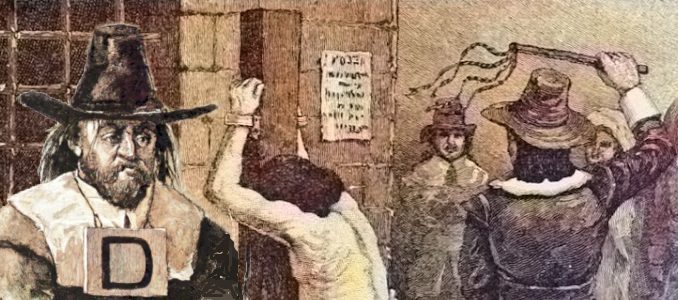
“It was characteristic of the times—every little Puritan community sought to know by every fireside, to hate in every heart, any offence, great or small,” wrote historian Alice Morse Earle in Curious Punishments of Bygone Days. “Since they were human, they sinned. But the sinners were never spared, either in publicity or punishment. Keen justice made the magistrates rigid and exact in the exposition and publication of crime, hence the labelling of an offender.”
In Nathaniel Hawthorne’s famous 1850 novel, The Scarlet Letter, Hester Prynne was forced to wear a capital letter A to signify adultery. Earle’s book, originally published in 1896, shares real-life examples of condemned colonials in New England. Harsh magistrates ordered them to wear capital letters “cut in cloth and sewed on their uppermost garment on the Arm and Back.” Failure to comply with that order resulted in the adjudged being “forthwith taken and publickly whipt.”1
“In 1656 a woman was sentenced to be ‘whipt at Taunton and Plymouth on market day,’” Earle wrote. The offender was also fined and ordered “forever in the future” to wear a Roman letter B cut from red cloth and sewn to her upper garment and on her right arm. The letter B signified blasphemy. Twenty years earlier, in 1636, one William Bacon was sentenced to stand an hour in the pillory wearing a large letter D to denote his habitual drunkenness.
In Boston, Robert Coles received a 10-shilling fine in 1633 for abusing himself “shamefully with drink.” That came with sentence to stand with a white sheet of paper on his back whereon “Drunkard” was scrawled. Unfortunately for Coles, he was a repeat offender. The next year, drunkenness led to his being ordered to wear a more prominent label proclaiming his sin: a red-letter D, cut and sewn onto white cloth, which Coles had to wear for a year. It had to be worn outwards, likely a measure to keep the wearer from turning it away from public view. That sentence came with additional penalties if he were caught without this badge of shame.2
Earle found other instances where the guilty were ordered to display more than a capital letter.
In the Connecticut colony in 1650, the General Court in Hartford found a man guilty of “contemptuous carriages” against the church and ministers. His was sentenced to stand two hours upon a four-foot-high block with a paper fastened to his chest, declaring in capital letters: “AN OPEN AND OBSTINATE CONTEMNER OF GOD’S HOLY ORDINANCES.”3
In 1639, Margaret Henderson of Boston was sentenced to stand in the marketplace with a paper that announced her “ill behavior.” That came with a fine of £5 which her husband was ordered to pay. “Widow Bradley of New London, Connecticut, for her sorry behaviour in 1673 had to wear a paper pinned to her cap to proclaim her shame.”4
How times have changed—or have they?
SEE related: Pious Pilgrims and Mayflower Misbehavior
NOTES AND REFERENCES
- Alice Earle Morse, Curious Punishments of Bygone Days (Chicago: Herbert S. Stone & Company, 1896), p. 87.
- Ibid., pp. 88-89.
- Ibid., p. 91.
- Ibid., p. 93.
